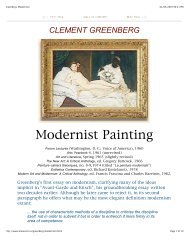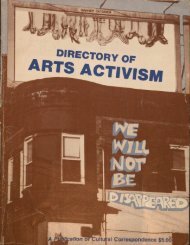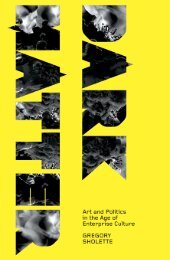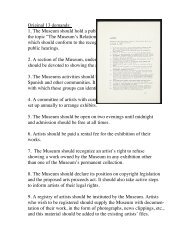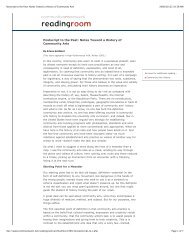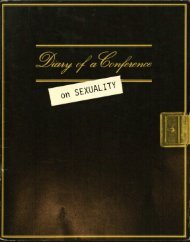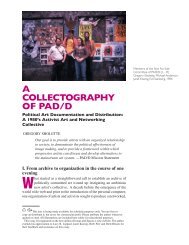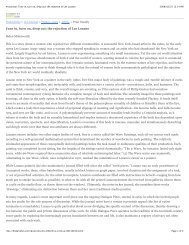Screen - Dark Matter Archives
Screen - Dark Matter Archives
Screen - Dark Matter Archives
You also want an ePaper? Increase the reach of your titles
YUMPU automatically turns print PDFs into web optimized ePapers that Google loves.
222 C MacCabe, 'TheDiscursive andthe Ideological inFilm', <strong>Screen</strong> vol19 no 4, p 36,3 P Willemen. 'Noteson Subjectivity On Reading 'SubjectiyityUnderSeige'. <strong>Screen</strong>vol 19 no I, p 55 .instead is to sketch the necessary components of such a study,to raise some theoretical questions which relate to <strong>Screen</strong>'s recentconcerns, and to give, in conclusion. a rather fuller account of theways in which this exercise might providea materialist reading !specifying/ articulations within the [picture}on determinate grounds. 2ITThere has been an impatience lately in the pages of <strong>Screen</strong> withthe idea tbat texts construct spectators, and an awareness thatfilms are read unpredictably, they can be pulled into more orless any ideological space, they can be mobilised for diverse andeven contradictory projects. 3This is an impatience I share, and in particular find myself agreeingwith Willemen thatthe activity of the text must be thought in terms of which set ofdiscourses it encounters in any particular set of circumstances, andhow this encounter may restructure both the productivity of thetext and the discourses with which it combines to form an intertextualfield which is always in ideology, in history. Some textscan be mdre or less recalcitrant if pulled into a particular field,while others can be fitted comfortably into it.It seems to me that Olympia in 1865 provides us with somethingclose to a limiting case of this recalcitrance; and one which,with the array of critical writing at our disposal. can be piecedout step by step. Recalcitrance is almost too weak a word, andinsignificance or unavailability might do better, for what we aredealing with in 1865 are the remains of various failures - a collectivefailure, minus Ravenel - to pull Olympia within the fieldof any of the discourses available. and restrucrure it in terms whichgave it a sense. There is a danger of exaggeration here, since thedisallowed and the unforgivable are in themselves necessary tropesof nineteenth century an critiosm : there ha d to be occupants ofsuch places in every Salon. But a close and comprehensive readingof the sixty texts of 1865 ought to enable us to distinguish betweena rhetoric of incomprehension. produced smoothly as part of theordinary discourse of criticism, and another rhetoric - a breakingor spoiling of the critical text's consistency - which is producedby something else. a real reca1citrance in the object of study. It isan open question whether what we are studying here is an instanceof subversive refusal of the established codes. or of a simple ineffectiveness;and it is an important question. given Olympia'scanonical (and deserved) status in the history of avant-garde art.IIIJ would like to know which set of discourses Olympia encounteredin 1865, and why the encounter was so unhappy. I think itis clear that two main discourses were in question: a discoursein which the relations and disjunctions of the terms WomanlNudelProstitute were obsessively rebearsed (which I shall call, clumsily,the discourse on Woman in the 1860s), and the complex but deeplyrepetitive discourse of aesthetic judgement in the Second Empire.These are immediately historical categories, of an elusive anddeveloping kind; rhey cannot be deduced from the critical textsalone, and it is precisely their absence from the writings onOlympia - their appearance there in spasmodic and unlikelyform - which concerns us most. So we have to establish, in thefamiliar manner of the historian, some picture of normal function·ing: the regular ways in which these two discourses worked, andtheir function in the historical circumstances of the 1860s.Olympia is a picture of a prostitute: various signs declare thatunequivocally. The fact was occasionally acknowledged in 1865:several critics called the woman courtisane, one described her as'some redhead from the quartier Breda' (the notorious headquartersof the profession). another referred to her as 'une manolo du basctage'. Ravenel tried to specify more precisely, calling her a 'girlof the night from Paul Niquet's' - in other words, a prostituteoperating right at the bottom end of the trade, in the all-night barru n by Niquet in Les Halles, doing business with a clientele ofmarket porters. butchers and chiffonniers. But by and large thiskind of recognition was avoided, and the sense that Olympia'swas a sexuality laid out for inspection and sale appeared in [hecritics' writings in a vocabulary of uncleanness. dirt, death.physical corruption and actual bodily harm. Now this is odd,because both the discourse on Woman in the 18605, and theestablished realm of arr, had normally no grear difficulty in includingand accepti ng the prostitute as one of their possible categories.There is even a sense, as Alain Corbin es rablishes in his study ofie discours prostilutionnel in the nineteenth century, in which theprostitute was necessary to the articulation of discourse onWoman in general:' She was maintained - anxiously and insistently- as a unity, which existed as the end-stop to a series ofdifferences which constituted the feminine. The great and absolutedifference was that between fille publique and fem me honnete:the twO terms were defined by their relation to each other. andtherefore it was necessary that the fille publique - or at least he rhaute bourgeoise variant. the courrisane - should have her repIe·senrations. The courtisane was a category in use in a well·estab·Iished and ordinary ideology: she articulated various (false) rela[ions between sexual identi[y. sexual power and social class. Of-----234 A Corbin, usFilles de noces.Misere sexuelle etprostitution aux1ge et 20e siedes,Paris 1978.



